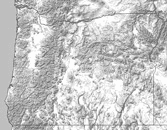Climate Refugia
Joint Inference from Fossils, Genetics, and Models
August 1-3, 2012
University of Oregon, Eugene, Oregon
Workshop Organizers: Dan Gavin (University of Oregon), Feng Sheng Hu (University of Illinois) and Solomon Dobrowski (University of Montana)
Workshop Participants
Rationale for the workshop
This workshop will convene geneticists, landscape ecologists, mountain climatologists, paleoecologists, and paleoclimatology experts to address how primary data relevant to population persistence through major climate changes can be used in a common framework to make the strongest possible inferences.
Biodiverse areas marked by endemism and populations disjunct from main distributions are arguably conservation priorities because of their species diversity, genetic distinctiveness, and biogeographic significance. Through the glacial intervals of the Quaternary, "refugial" areas for temperate tree species, inferred by paleorecords, were located hundreds to thousands of km from the ice sheets. Over the past two decades evidence has accumulated that, in addition to low-latitude refugia, mid- and high-latitude refugia existed that supported warm-adapted species. Such populations decrease the risk of extinction of species with low mobility that would otherwise be required to migrate long distances to areas with a suitable climate. Small isolated (cryptic) northern refugia would have served as important predispersed nuclei for postglacial range expansion. Indeed, population histories involving persistence through glacial periods and subsequent range expansion data may partly explain modern patterns of biodiversity from the Arctic to the tropics.
How species persisted through the large climatic changes of the Pleistocene has been a long-standing focus of paleoecological research. However, because paleoecological archives are patchy, and potential refugia are small, holes remain in our understanding of the importance of northern refugia. Recently, phylogeography and distribution modeling have offered new insights unavailable from paleorecords, but the genetic and modeling approaches have not interfaced with the paleoecological community, and such studies are often made with little explicit reference to the paleorecord.
This workshop will bring together researchers who work on historical reconstruction of populations from different disciplines and to assess the prospect for a best-evidence synthesis to leverage the results from any one approach. The foci will include: 1) climate relicts and patterns of endemism, 2) paleoecology studies, 3) phylogeography studies that support presence of refugia, and 4) mountain climatology and species distribution modeling including topographic influences on microclimates under present and past climates. The Pacific Northwest is an excellent setting for this topic because textbook examples of northern refugia exist from the Olympic Mountains, northern Idaho, and Beringia.
| We are grateful for funding from: | |
 |
 |
 |
Department of Geography University of Oregon 107 Condon Hall 1251 Univ. Oregon Eugene, OR 97403-1251
|
 |